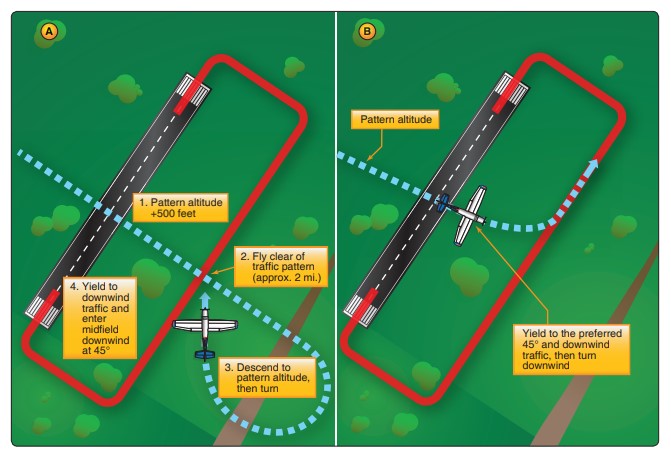I have a question for real world pilots concerning non controlled airports.
Let’s suppose I want to land at Diamond Point (or any other uncontrolled airport), how do I enter the pattern circuit if I don’t know the wind direction?
In order to understand the wind direction I have to look at the windsock, this implies flying over the airfield at low altitude, probably close to the traffic pattern one or a bit higher to avoid interfering with the airplanes circuiting, but this is just a guess.
How is it done in real world? How do I get close to an airport to check the windsock and then enter the circuit?
thanks.
There are probably different opinions but I would announce my position on CTAF and listen for other pilots to announce their position in the pattern. This will indicate the runway in use. If I am the only one on the frequency, then I would fly at pattern altitude across the middle of the runway and check the wind. Depending on the pattern direction, you can either enter downwind or upwind leg once you have the prevailing winds.
In the real world you can use other sources to give you wind direction like smoke or tall grass fields.
In any case, communication is key even at uncontrolled airports.
Depends on the country, but in the US it is getting more and more unlikely to not be able to get some sort of basic AWOS / ASOS. If not, options are:
- try to reach someone on the common frequency that can provide winds
- listen to what other traffic is doing in the area
- Listen to AWOS from a nearby airport
- Use forecasted winds from preflight
In reality, if winds are strong enough to matter you can look at your ground track as you are approaching the field, or other cues such as smoke, flags, water, etc.
And like you said, overfly the field as you enter the pattern and look for a windsock. Or the rare airport that still has a tetrahedron.
Standard procedure would be to cross mid field, 90 degrees to the runway above circuit altitude to confirm wind direction and no obstructions. Once you have determined the wind clear the immediate are and make a radio call declaring your intentions and join the appropraite pattern for the airport, again using a ‘cross midfield pattern entry’. Be sure to make, at the very least a “downwind” call and an “on final” call.
thanks, what you all wrote is what I was expecting.
unfortunately, as of now, we have almost no AI aircraft in patterns and it seems also realplayers CTAF announcements are not received by other players which is a shame.
Usually I look at airnav to see if there’s a nearby airport with AWOS/ATIS but in some cases, e.g. Ranger Creek, there’s nothing ![]()
Smoke and other visual cues are something we really really need. In some previous iterations for some addons (I’m thinking Chelan Georender as a good example), back in FS2004 we had windmills or smoke that were influenced by the wind direction, that was very nice.
ps: I’d really like to mark “Solution” for all posts but the forum does not allow for multiple solutions.
This is 100% correct as a standard operating procedure. Don’t know if this is still taught during training to get your PPL, but this was/is common practice for us grey beards who learned to fly when “touch-tone” phones were new technology.
![]()
Whilst discussing procedures for uncontrolled airfielfs, I’ve often wondered why flight simulators don’t provide an option for an overhead join/rejoin as this has been the procedure at most airfields I have flown into in the UK.
Most of the “airports” I use, both IRL and in the sim are pretty devoid of any traffic anyway. Some strips I even call ahead to the “operator” to have them run out with a D6 dozer to scrape the mud/snow off so I CAN land.
In general I make the calls just to trigger the proper procedures/checks.
The solution to that is to quote any posts you feel answered your question and activate ‘Solution’ for that post.
I can flag only one post but would like to flag three. Unfortunately, you can’t, “there can be only one”
This image was clipped from the “Airplane Flying Handbook” published by the FAA
Here’s the link to that resource…
You would of course have to turn off the one already clicked. Then quote the all you chosen posts like I did in this one. I f you like you can summarize, then post.
Then you should be able to apply the solution checkbox to that post.
As the above post about overhead join i would agree with but I would do the following;
- Call position and intentions for overhead join as you approach the airfield (include alt of join for clarity)
- Fly over the airfield at 2,000ft, (assuming circuit height is 1,000 ft) (call 'overhead)
- Establish from the wind sock the direction of wind and runway heading, also look for traffic in circuit and moving on ground, (announce intentions)
- Join the upwind (ie none traffic side) and begin decent down to circuit height. (announce decent into circuit)
- Aim to decent on the upwind and cross wind leg to join down wind at circuit height.(announce downwind)
- Continue on circuit as normal, downwind, Base and finals.
Joining upwind will give you more time to ■■■■■ wind and critically traffic. Descending on upwind leg ie to the right/left of the runway (dependant on circuit direction, not directly over the runway, there is less likelihood that you will be descending onto an aircraft in the circuit and underneath that you haven’t spotted.
Any traffic in the circuit has priority.
Hope that helps.
This topic was automatically closed 30 days after the last reply. New replies are no longer allowed.
